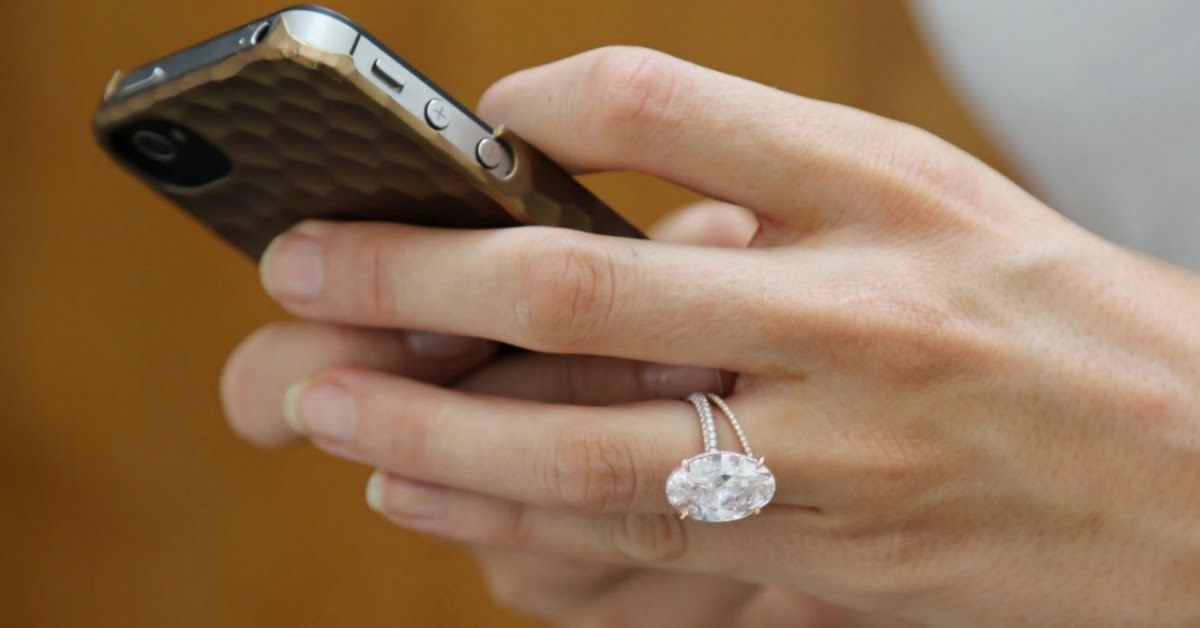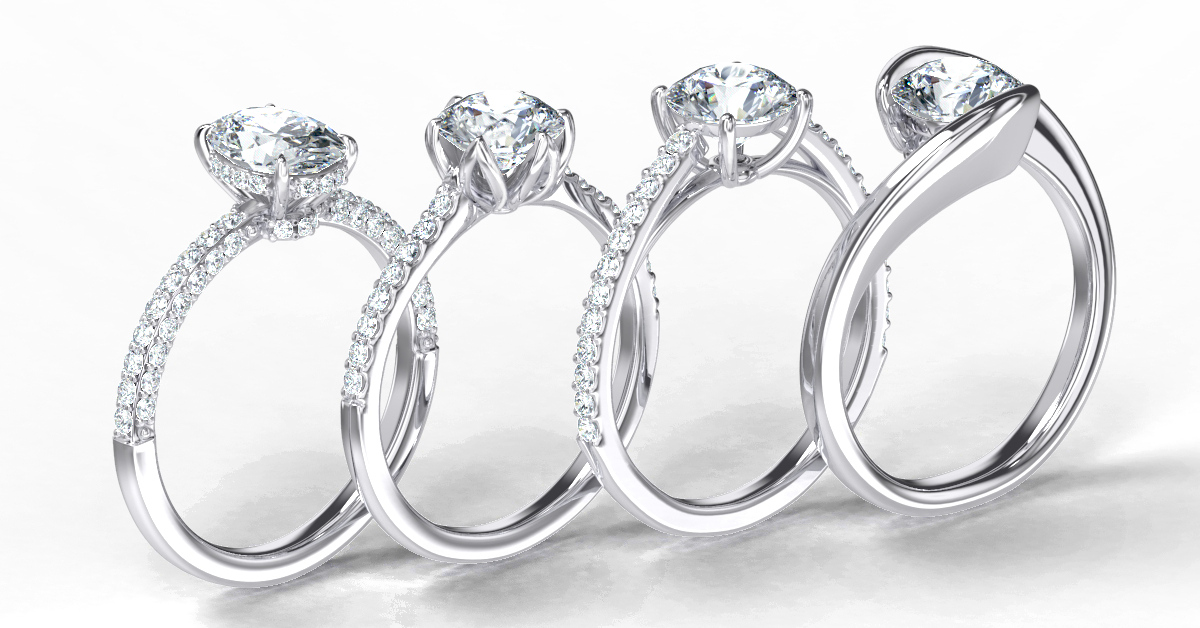Talking about wear and tear might not seem like fun… but do you know what’s even less fun?
Seeing your precious engagement ring age in dog years.
Work.
Hobbies.
Environment.
These real world issues need to be taken into account when designing or choosing an engagement ring.
First of all – everyone knocks and bumps their ring a few times per day. If you’re a woman, think about the 10 minutes after painting your nails. You’re walking around with forked out frog hands obsessively dodging every thing.
If you wear your engagement ring this way – wear and tear would be a foreign concept.
But that’s just not the life of an engagement ring.
Yes, engagement rings should be able to withstand normal daily life, but they’re far from bulletproof. And just knowing this is a great start.
Risky Situations.
For starters, this is a wonderful example of a stunning diamond that will be missing in action before dinner:

Here’s where, and how, you might run into trouble;
Any hard knock warrants a visit to your jeweller. These happen, and it’s normal. If a claw has been bent it can usually be realigned in a few minutes. Rather have your ring checked out than having your diamond fall out, right?
The accumulation of small knocks and bumps might compromise the setting’s structure over time. A hundred knocks might leave your ring A-Okay, but bump 101 = damage. Visit us once a year for a check-up, and you’ll have reset the counter to zero. If you never have your ring inspected you should actually be surprised if it stays in tip-top shape year after year. Make time for the check-ups.
“We’ll beat any quote” jewellers. If a jeweller’s sole mission is to be the cheapest, quality has to take a backseat. We’re very often the best priced, but we don’t do any discounts, because we don’t cut corners. Cheap diamond rings can end up being very expensive when they have to be properly remade.
Three steps to engagement rings that last.
Step 1: Fine-tune the design.
How well an engagement ring will “age” actually starts way before you even lay eyes on it…
Some designs are just more durable than others.
But a great, experienced designer will be able to ensure that whatever design you love can walk the fine line between being beautiful and durable.
For example; everyone wants the claws and prongs holding their diamonds in place to be as close to invisible as possible. Unfortunately, they’re also then missing in action when you need them to actually safeguard your diamonds.
I don’t want to overuse the word “experience” but it’s the key element here. Experienced designers know when certain ideas and elements start getting risky. Listen to their feedback. They can help you align form and function, and set you up with a design that will look amazing years down the road.
A few occupations that are notoriously hard on engagement rings;
Teachers. Even high-school.
Athletes and fitness junkies that don’t want to worry about their engagement rings 24/7.
Nurses and doctors.
Construction and design jobs where samples of granite, tiles and other hard materials are handled frequently.
Chefs.
Stay at home moms. Not surprisingly.
If you work or spend time in any of these areas – tell your designer.
Our commitment to quality is obsessive, and we won’t manufacture a ring that wouldn’t stand the test of time. We’d rather lose a sale than craft compromised designs. We’re thousands of engagement rings in, and we have never had a single return due to poor quality.
Some input from our very best designer;
A lot of what makes a good, long-lasting engagement ring is just common sense applied properly. No magic here.
Regardless of your design preference, chances are excellent that we’ve previously designed and manufactured very similar or identical rings. We’re most probably not starting on zero when working on your design. And you have access to that wealth of experience.
Remember, your engagement ring’s life only starts when it’s slipped onto the ring finger, and from that moment it’s joining you on every single trip and outing. Let’s plan for that.
This is a highly tailored part of the ring design, so it is difficult to give a general spread, but here is what we consider:
Setting Styles
Simpler settings like the solitaire are inherently more durable than complex designs.
With solitaire designs gaining popularity “Would you recommend four or six claws for my main diamond?” is a question we hear a lot.
Surprisingly, the difference between a four or six claw setting is mainly visual.
The four claw variant draws the eye towards a square where the six or eight claw setting draws the eye into a circle.
If, however, the ring is going into a war-zone and one claw was to fail, you will find the five remaining claws will hold a diamond securely in place. Tube and tension settings seem slightly lower in popularity these days but both are very safe bets.
Height
Very few people deliberately ask for an overly high setting. It can be uncomfortable, but it’s also risky to be accidentally banging your ring around all day. Height is just another design element that needs to be in perfect harmony to the others.
In fear of a “tower of Babel” inspired ring, folks often overshoot and think a ring should be as flat and low as possible.
I get that.
And there are scenarios where I recommend exactly that.
But it’s a lot less than you think.
A design often comes out richer, fuller and just generally better if it is allowed to breathe a bit in the height department. This does not mean we do not take the height into consideration regarding the practicality of the ring. Let’s take a look at what I like to call the flow of the design, and consider what the ring does with the height it has.

The left most ring, our Fenne, has a single thickness all the way around. This type of design puts a lot of pop on the centre stone but, for some lifestyles the claw is slightly exposed and would take some punishment.
The next ring, Evaline, just brings up subtle shoulders to support the stone and creates a sort of “ramp” for impact to bounce over the ring. This is a great design feature and should be practical for most lifestyles.
The third ring in the line, Ebele, offers rounded shoulders to the ring. This profile properly shields the ring and is recommended for anyone who works a lot with their hands.
The last one is the Eleanor, a second variant of the rounded shoulders. This is the type of approach we typically recommend for medical professionals, with smooth edges and minimal steps. There’s also no claw in sight to tear a glove.
I analysed these rings purely on their practical appeal, irrespective of aesthetics. We can always make a plan to make a design work. Details such as halos, filigree, vintage finishes or anything that you would like remains on the table, we will just be smarter when we put everything together.
Step 2; Choose the right metal and gemstones.
Metal
Did you know that you can literally indent your nail into a bar of pure gold? It’s that soft.
That’s why 100% pure gold is never used in jewellery and metals like palladium are added to the mix to bring in some much-needed strength and hardness.
Unless you’re looking for a rose or yellow colour, palladium and platinum are way more durable than 18k white gold. Over 90% of the work we do currently is in platinum. It’s a fantastic metal.
Diamonds vs Gemstones
This is probably the first piece of jewellery you’ll be wearing every day, all day, for a few decades.
Diamond is the hardest natural substance on Earth. It can’t scratch. Even if you try.
A diamond will look just as great in 30 year’s time as it does today. That makes it the absolute best choice for a piece of daily jewellery like an engagement ring.
Since diamonds are so durable we offer an upgrade plan where you receive 100% credit for your Poggenpoel diamond purchase whenever you wish to upgrade. I know when you trade in your diamond it will be as good as new.
All gemstones other than diamonds will pick up scratches in all shades of severity. What can you do? The world is abrasive.
Moissanite, sapphire and ruby are the most durable diamond alternatives. We stock all three if you’d like to come over and take a look.
Step 3; Good old yearly maintenance. Exciting!
Regardless of design, metal or gemstone choice, have your ring visit us for a clean and check-up (on the house) at least once per year, and after any significant knock. We use microscopes to check for any fractures in the metal and run every ring through a quality control cycle as if it was manufactured today.
It’s your ring, but I’m proud of our work, and I’d like to keep it in top-notch shape for you.
A good mindset would be to think of your engagement ring in the same vein as your smartphone. It’s an expensive everyday item that needs some extra care and TLC.
Come over for a coffee with one of our designers.
We have studios in both Rosebank and Pretoria where you can have a no-pressure session with one of our designers to discuss your engagement ring ideas.
With due care and creativity, we can execute the design you love in a durable way – so that you can simply enjoy it.
Awesome! That’s it. If you have any questions, I’m available in the comments or you can reach out via johan@poggenpoel.com
Take care.
Johan Poggenpoel
T; 012 111 0525 (Pretoria) | 010 020 6811 (Johannesburg) | Frisco, Texas Coming Soon.
E; info@poggenpoel.com
Instagram:https://www.instagram.com/poggenpoeljewel/
Facebook; www.facebook.com/poggenpoel
